| Welcome
to the Fall Recital Concert 2003 Web Page! |
On
Monday evening, October 20th, 2003, at the SweetMusik Studios in
Cupertino, we were privileged to hear some excellent new musicians
performing at the piano. We heard examples from the 4 major time
periods of music, Baroque, Classical, Romantic, and 20th Century.
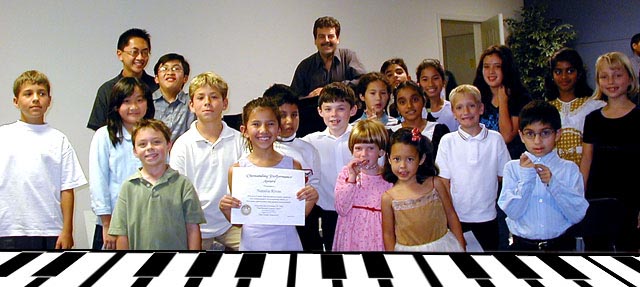
The performers and their performance pieces are listed below; click on the performer's
name to see the performer's picture. |
|
New
Sounds |
| Srivas Tirumala "The Rainbow" |
Norie Omiya "Whirlwind Boogie" |
| Kathryn Ziegler "Mary Had a Little Lamb" |
Kartik Mukkavilli "Itsy Bitsy Spider" |
| Mary Manchester "Harmonic Waltz" |
|
|
Baroque
(1600-1750)
|
| Julio Pereyra "Prelude No. 1" (Bach) |
Arany Uthayakumar "Prelude No. 3" (Bach) |
| Natalie Wong "Canon in D"
(Pachelbel) |
|
Classical
(1750-1820)
|
| Charles Manchester "Ode to Joy" (Beethoven) |
Natalia Rivas "Minuet in G"
(Haydn) |
| Natalie Popescu "Gypsy Rondo"
(Haydn) |
Derek Wong "Sonatina Op.49 No.2" (Beethoven) |
|
Romantic
(1820-1910)
|
| Casey Wong "Hall of the Mountain King"
(Grieg) |
|
20th
Century Music (1900
to 2000)
|
| Ethan Van Steenburgh "Blues in C" |
Celina McCaffrey "Auld Lang
Syne"
|
| Ciara McCaffrey "Maple Leaf Rag" (Joplin) |
Udayan Gupta "Cantina Song (Star Wars)" |
| Gabriel Pereyra "Star Wars Theme" |
Manassa Padmanabhan "Mexican Hat Dance" |
|
Baroque Music (1600-1750)
The ornate music harpsichord and organ music of the eighteenth century known as "Baroque" was dominated by the genius of Bach and Handel. Bach composed music for almost every genre except opera; he left a corpus of liturgical music, including cantatas, that show the influence of Luther's Reformation on musical style. Handel, as a German- born composer studied in Italy and worked many years with much success in England.
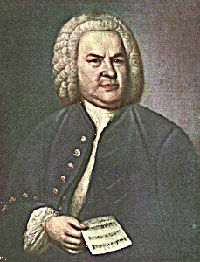 Bach is considered by many to have been the greatest composer in the history of western music. Bach spent the height of his working life in a Lutheran church position in Leipzig, as both organist and music director. Bach used all the musical styles of his time: German, French, Italian & English, while retaining a personal identity and creating an astounding amount of material. Bach is considered by many to have been the greatest composer in the history of western music. Bach spent the height of his working life in a Lutheran church position in Leipzig, as both organist and music director. Bach used all the musical styles of his time: German, French, Italian & English, while retaining a personal identity and creating an astounding amount of material.
|
Classical Music (1750-1820)
Haydn and Mozart dominated the music of Western Europe in the Classical era. From here we also find the operas of Rossini, Donizetti and Bellini. The classical style may be seen to culminate in the music of Beethoven, who is perceived as the link between the classic and romantic style.
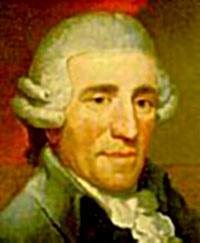 Joseph Haydn was the father of many of the classical forms as they have survived to modern times; the symphony, the concerto and the string quartet. These forms that he produced laid down the framework for these styles for composers for the next 200 years. Beethoven, Haydn's most famous pupil, was especially influenced by his
mentor. Joseph Haydn was the father of many of the classical forms as they have survived to modern times; the symphony, the concerto and the string quartet. These forms that he produced laid down the framework for these styles for composers for the next 200 years. Beethoven, Haydn's most famous pupil, was especially influenced by his
mentor.
|
Romantic Era Music (1820-1910)
The early Romantic composers include Brahms, Schubert, Chopin, Grieg, Wagner, Liszt, Mendelssohn, Schumann, Strauss, Mahler, Verdi, Debussy, and Ravel. This period marked an increased development of the symphony, grand opera, the piano sonata, national musical style, and the expansion of tonality and harmonic practice.
 Norwegian composer. Grieg developed a strongly nationalistic style which made him known as "the Voice of Norway." In 1869, Grieg established his fame as a leading composer with his Concerto in A Minor for piano and orchestra, appearing himself as the solo pianist in its first performance. He is also famous for the suite of incidental dramatic music, Peer Gynt (1876). Norwegian composer. Grieg developed a strongly nationalistic style which made him known as "the Voice of Norway." In 1869, Grieg established his fame as a leading composer with his Concerto in A Minor for piano and orchestra, appearing himself as the solo pianist in its first performance. He is also famous for the suite of incidental dramatic music, Peer Gynt (1876).
|
20th Century Music (1900 to 2000)
Twentieth-century music includes many different styles including electronic music, jazz, pop, experimental, neoclassical, country, rock and roll. Some of the composers famous in the "serious music" world include Gershwin, Stravinsky, Boulez, Cage, Glass, Rogers, Berlin, Copeland, Ives, and Bernstein.
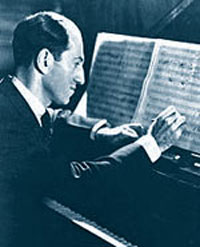 American composer George Gershwin was essentially self-taught. He was first a song plugger in Tin Pan Alley and an accompanist. In his teens he began to compose popular songs and produced a succession of musicals. He wrote Rhapsody in Blue as a concerto for piano. Its success led him to devote increasing energy to 'serious' composition, like the Piano Concerto in F (1925) and the tone poem An American in Paris (1928). American composer George Gershwin was essentially self-taught. He was first a song plugger in Tin Pan Alley and an accompanist. In his teens he began to compose popular songs and produced a succession of musicals. He wrote Rhapsody in Blue as a concerto for piano. Its success led him to devote increasing energy to 'serious' composition, like the Piano Concerto in F (1925) and the tone poem An American in Paris (1928).
|
|
Fall
Recital 2001 Spring
Recital 2002 Fall
Recital 2002 Spring
Recital 2003 |
|
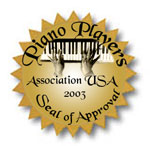
"Blues in C", ©2003 by Paul Alan Smith
Redeemer Lutheran Church and
SweetMusik Studios are both located in Cupertino, CA |
|
Contact Piano Instructor - Paul Smith (408)-535-8751
http://www.musicandlight-unlimited.com/recital2003/fall_03.htm |